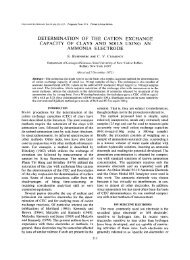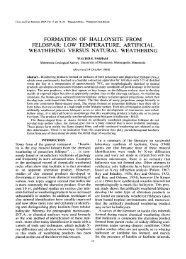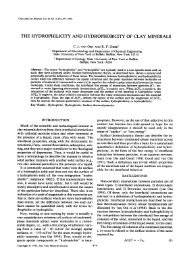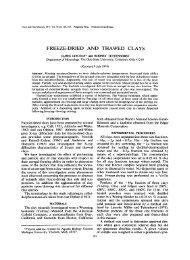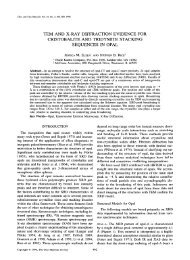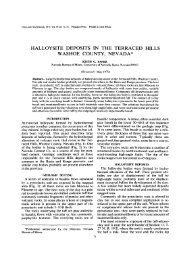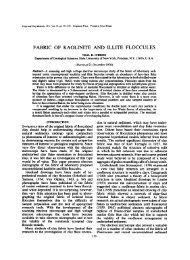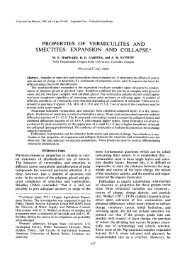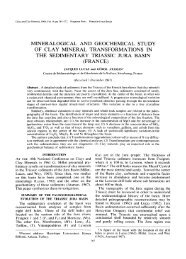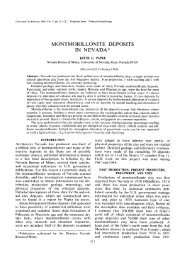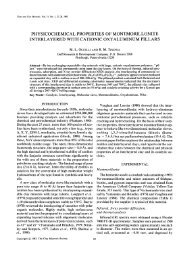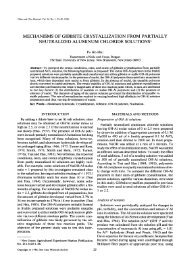a mossbauer investigation of glauconite and its geological significance
a mossbauer investigation of glauconite and its geological significance
a mossbauer investigation of glauconite and its geological significance
You also want an ePaper? Increase the reach of your titles
YUMPU automatically turns print PDFs into web optimized ePapers that Google loves.
Clays <strong>and</strong> Clay Minerals, Vol. 27, No. 5, pp~ 339-348, 1979.<br />
A MOSSBAUER INVESTIGATION OF GLAUCONITE<br />
AND ITS GEOLOGICAL SIGNIFICANCE<br />
D. M. McCONCHIE, a J. B. WARD, 2 V. H. MCCANN, 3 AND D. W. LEwis 4<br />
Ahstraet--M6ssbauer spectra <strong>of</strong> 9 <strong>glauconite</strong> samples from Upper Cretaceous <strong>and</strong> Lower Tertiary strata<br />
in the South Isl<strong>and</strong> <strong>of</strong> New Zeal<strong>and</strong> contain a broad shoulder due to low intensity absorption continuous<br />
between 1.0 <strong>and</strong> 2.5 mm/sec when the absorber is at room temperature; the shoulder is absent, <strong>and</strong> sharp<br />
peaks are apparent in spectra taken with the absorber at 80~ The data suggest that electron transfer<br />
occurs between adjacent Fe 3+ <strong>and</strong> Fe z+ ions at room temperature. The low temperature spectra indicate<br />
that all Fe in the <strong>glauconite</strong>s is in octahedral coordination. Fe z+ <strong>and</strong> Fe z+ ions occur in both cis <strong>and</strong> trans<br />
sites; Fe z+ shows a strong preference for cis sites whereas Fe 2+ shows an even stronger preference for trans<br />
sites.<br />
The partially variable oxidation state <strong>of</strong> Fe in <strong>glauconite</strong> is interpreted in terms <strong>of</strong> a geochemical model<br />
for glauconitization <strong>of</strong> a degraded or incomplete progenitor phyllosilicate. The model involves exchange<br />
<strong>of</strong> Fe ~+ for other cations which temporarily stabilize the progenitor, followed by FeZ§ 3+ charge transfer<br />
reactions. Each reaction results from the system's tendency towards equilibrium. The model is supported<br />
by the observation that artificially leached <strong>glauconite</strong> increases both <strong>its</strong> Fe z+ <strong>and</strong> <strong>its</strong> Fe z+ content when<br />
placed in a solution containing Fe 2+ as the only Fe ion present.<br />
Key Words---Genesis, Glauconite, Iron oxidation, Mrssbauer spectroscopy.<br />
INTRODUCTION<br />
The M6ssbauer technique uses nuclear gamma res-<br />
onance to produce absorption spectra which are sen-<br />
sitive to interactions between the nucleus <strong>and</strong> the ex-<br />
tranuclear electric <strong>and</strong> magnetic fields. In <strong>its</strong> most basic<br />
form, the technique indicates the relative occupancies<br />
<strong>of</strong> different lattice sites by absorber atoms in different<br />
oxidation states, the presence <strong>of</strong> certain defects or dis-<br />
tortions in the crystal structure, <strong>and</strong> the variability (if<br />
any) in the oxidation state <strong>of</strong> the absorber atoms. This<br />
paper amplifies earlier studies by M/Sssbauer analysis<br />
<strong>of</strong> the sedimentary mineral <strong>glauconite</strong> (cf. Rolf et al.,<br />
1977; Rozenson <strong>and</strong> Heller-Kallai, 1978).<br />
In this paper the term <strong>glauconite</strong> is restricted to<br />
greenish iron- <strong>and</strong> potassium-rich hydrated alumino-<br />
phyllosilicates with 2:1 layer lattices; there may be a<br />
high proportion <strong>of</strong> exp<strong>and</strong>able layers, but the nonex-<br />
p<strong>and</strong>able components must be illitic (McRae, 1972).<br />
The presence <strong>of</strong> <strong>glauconite</strong> has been widely used as an<br />
indicator <strong>of</strong> paleoenvironments, <strong>and</strong> the conditions un-<br />
der which it forms have been summarized by many au-<br />
thors (e.g., Cloud, 1955; Burst, 1958a, 1958b; McRae,<br />
1972) although the chemistry <strong>of</strong> <strong>glauconite</strong> genesis re-<br />
i Department <strong>of</strong> Geology, University <strong>of</strong> Geology, Christ-<br />
church, New Zeal<strong>and</strong>. Present address: Geology Department,<br />
University <strong>of</strong> Western Australia, Nedl<strong>and</strong>s, Western Austra-<br />
lia 6009, Australia.<br />
z Department <strong>of</strong> Physics, University <strong>of</strong> Canterbury, Christ-<br />
church, New Zeal<strong>and</strong>.<br />
3 Department <strong>of</strong> Physics, University <strong>of</strong> Canterbury, Christ-<br />
church, New Zeal<strong>and</strong>.<br />
4 Department <strong>of</strong> Geology, University <strong>of</strong> Canterbury, Christ-<br />
church, New Zeal<strong>and</strong>.<br />
Copyright 9 1979, The Clay Minerals Society 339<br />
mains poorly understood. In this paper explanations for<br />
some <strong>of</strong> the chemical aspects <strong>of</strong> <strong>glauconite</strong> genesis,<br />
based on Mrssbauer studies <strong>of</strong> selected New Zeal<strong>and</strong><br />
<strong>glauconite</strong>s, are proposed.<br />
EXPERIMENTAL<br />
Sample collection, analysis, <strong>and</strong> classification<br />
All samples were obtained from Upper Cretaceous<br />
<strong>and</strong> Lower Tertiary formations in the South Isl<strong>and</strong> <strong>of</strong><br />
New Zeal<strong>and</strong> (see Figure 1). A range <strong>of</strong> morphological,<br />
crystallographic, <strong>and</strong> compositional varieties <strong>of</strong> glau-<br />
conite was selected (see Table 1) from an original col-<br />
lection representing 142 localities (McConchie, 1978).<br />
Approximately 1 kg <strong>of</strong> each sample was disaggregated<br />
in warm water <strong>and</strong> wet sieved to retain the size fraction<br />
between 0.125 mm <strong>and</strong> 1.0 mm. The use <strong>of</strong> a Frantz<br />
Isodynamic Magnetic Separator, followed by the man-<br />
ual removal <strong>of</strong> contaminants, produced concentrates<br />
containing only <strong>glauconite</strong> grains.<br />
The morphology <strong>of</strong> the <strong>glauconite</strong> grains was deter-<br />
mined using a binocular microscope, <strong>and</strong> their crystal-<br />
lographic properties were studied with a Philips X-ray<br />
powder diffractometer using oriented mounts; no con-<br />
taminants were detected in any <strong>of</strong> the samples. Both<br />
the proportion <strong>of</strong> layers in the <strong>glauconite</strong> crystallites<br />
with a variable basal spacing (% exp<strong>and</strong>able layers--<br />
see McRae, 1972) <strong>and</strong> the disorder coefficient (DC)<br />
were determined. The disorder coefficient (Mc-<br />
Conchie, 1978) is a measure <strong>of</strong> crystallographic disor-<br />
der <strong>and</strong> is defined as DC = (~" b)/(h - b); where ~- is the<br />
half-height line width <strong>of</strong> the 10-A_ reflection measured<br />
in ~ using an oriented sample fired at 400~ for 1 hr;<br />
h is the intensity <strong>of</strong> the 10-A_ peak; <strong>and</strong> b is the back-
340 McConchie, Ward, McCann, <strong>and</strong> Lewis Clays <strong>and</strong> Clay Minerals<br />
45~S<br />
i i i<br />
Figure 1. Location map for sampled outcrops, South Isl<strong>and</strong>,<br />
New Zeal<strong>and</strong>, UC numbers refer to samples stored in the Ge-<br />
ology Department, University <strong>of</strong> Canterbury, whence details<br />
on location <strong>and</strong> stratigraphy can be obtained.<br />
ground intensity (h <strong>and</strong> b have the same arbitrary length<br />
un<strong>its</strong>). In combination, the disorder coefficient <strong>and</strong> the<br />
% exp<strong>and</strong>able layers determine the crystallinity class<br />
<strong>of</strong> each <strong>glauconite</strong> sample (see Table 1).<br />
Chemical analyses <strong>of</strong> all samples (see Table 2) were<br />
performed by X-ray fluorescence techniques, <strong>and</strong> the<br />
total water content <strong>of</strong> the samples was determined as<br />
a percent weight loss on firing to 700~ for 1 hr, after<br />
correcting for Fe 2+ oxidation. Differential thermal anal-<br />
ysis curves for <strong>glauconite</strong> (Grim, 1968; McConchie <strong>and</strong><br />
Lewis, 1978) show that essentially all dehydration <strong>and</strong><br />
dehydroxylation ceased by this temperature <strong>and</strong> that<br />
structural changes took place at higher temperatures.<br />
The Fe2+/Fe z+ ratio was determined from the M6ss-<br />
bauer spectra <strong>of</strong> the <strong>glauconite</strong>s using relative peak<br />
areas; wet chemical methods were not used because if<br />
charge transfers occur in <strong>glauconite</strong>s at room temper-<br />
ature, as suggested by the Mrssbauer spectra taken in<br />
this study, then changes in the Fe2+/Fe 3+ ratio may oc-<br />
cur during wet chemical analyses.<br />
MOssbauer analysis<br />
Specimens for M6ssbauer analysis were prepared by<br />
grinding a subsample <strong>of</strong> the <strong>glauconite</strong> extract to
Vol. 27, No. 5, 1979 MOssbauer <strong>investigation</strong>s <strong>and</strong> genesis <strong>of</strong> <strong>glauconite</strong><br />
Table 1. Morphological <strong>and</strong> crystallographic classification <strong>of</strong> the <strong>glauconite</strong>s.<br />
Percent<br />
Sample Disorder exp<strong>and</strong>able<br />
No. ~ Morphology 2 coefficient s layers Class 4 Crystallinity 5<br />
UC8456 V 5%, ZA 94%, 0.61 30 interlayered 2b (extremely disordered)<br />
pigmentary 1%<br />
UC8458 L 90%, D 10%, 0.35 20 disordered 2a (moderately disordered)<br />
UC8481 L trace, FA 70%, 0.33 10 disordered 2a (moderately disordered)<br />
FB 30%<br />
UC8485 Z A/B 60%, L 10%, 0.16 4 ordered (mineral) 1 (ordered)<br />
FA 25%, FB 5%<br />
UC8495 L 70%, D 10%, 0.75 45 interlayered 3 (interlayered)<br />
Z A/B 20%<br />
UC8521 Z A/B 100% 0.16 20 ordered (mineral) 1 (ordered)<br />
UC8540 L 50%, V trace, 0.39 4 disordered 2a (moderately disordered)<br />
FA 40%, D 10%<br />
UC8550 L 30%, V 60%, FA 10% 0.85 30 interlayered 2b (extremely disordered)<br />
UC8555 Z A/B 90%, L 1%, 0.58 30 interlayered 2b (extremely disordered)<br />
V 5%, D 1%, FA 3%<br />
1 See Figure 1 for sample locations.<br />
2 V = vermicular; L = lobate; FA = fragmentary <strong>glauconite</strong> subclass A; FB = fragmentary <strong>glauconite</strong> subclass B;<br />
ZA = spongy <strong>glauconite</strong>, cauliflower subclass; ZB = spongy <strong>glauconite</strong>, serrulate subclass; D = ovoid. Terminology <strong>of</strong><br />
Triplehorn (1966) <strong>and</strong> McConchie (1978).<br />
3 For definition <strong>of</strong> the disorder coefficient (DC) see text.<br />
4 Crystallographic classification <strong>of</strong> the <strong>glauconite</strong>s using the method <strong>of</strong> Burst (1958a).<br />
5 1 = ordered; DC ~< 0.25. 2a = moderately disordered; 0.25 < DC ~< 0.5, % exp<strong>and</strong>able layers < 40%. 2b = extremely<br />
disordered; DC > 0.5, % exp<strong>and</strong>able layers < 40%. 3 = interlayered: % exp<strong>and</strong>able layers > 40% (after McConchie, 1978).<br />
amplitudes <strong>and</strong> areas caused by saturation. The result-<br />
ing lines are narrower by about 0.1 mm/sec, <strong>and</strong> spec-<br />
tral resolution is thus greatly improved. In the second<br />
stage, ideal pairs <strong>of</strong> Lorentzian curves were fitted to the<br />
deblackened experimental data (Figure 4). The fitting<br />
program was designed to provide a minimum value for<br />
X 2 but because the deblackening process applied a<br />
smoothing correction (see Dibar Ure <strong>and</strong> Flinn, 1971)<br />
<strong>and</strong> refined the raw data, the numerical value <strong>of</strong> X 2 for<br />
341<br />
the comparison <strong>of</strong> the experimental data <strong>and</strong> the fitted<br />
curves is not an adequate indicator <strong>of</strong> goodness <strong>of</strong> fit.<br />
Hence, goodness <strong>of</strong> fit must be determined by visual<br />
examination <strong>of</strong> the relationship between the deblack-<br />
ened experimental data <strong>and</strong> the fitted curves (see Figure<br />
3). Finally, the deblackened experimental data <strong>and</strong> the<br />
calculated fit were plotted on a graph (Figure 4), <strong>and</strong><br />
the computed curve parameters were tabulated (Table<br />
3).<br />
Table 2. Concentrations <strong>of</strong> major elements in the studied <strong>glauconite</strong>s.<br />
wt %<br />
Total<br />
Sample Fe as<br />
number SiOz A1203 Fe203 MgO CaO KzO Na.zO TiO2 H20 FC+/Fe 3+<br />
UC8456 57.6 9.9 17.5 0.75 0.23 6.60 0.90 0.52 5.67 0.159<br />
UC8458 53.2 4.3 25.6 1.21 0.63 8.34 0.40 0.13 5.28 0.244<br />
UC8481 53.1 6.7 21.9 2.41 0.84 6.91 0.27 0.90 5.21 0.608<br />
UC8485 54.5 4.0 23.6 0.89 0.09 7.81 0.45 0.30 6.20 0.016<br />
UC8495 55.1 7.0 20.2 2.07 1.12 4.30 1.37 0.30 7.28 0.122<br />
UC8521 53.2 6.7 24.6 0.41 0.25 6.02 0.72 0.41 6.58 0.007<br />
UC8540 53.3 4.3 25.3 0.43 0.64 7.91 0.08 0.22 5.41 0.292<br />
UC8550 50.2 5.4 28.6 0.11 0.75 6.72 0.25 0.33 7.23 0.072<br />
UC8555 55.7 6.5 22.9 0.40 0.47 6.42 0.85 0.42 5.94 0.111<br />
See Figure 1 for sample locations. All concentrations are expressed as weight % <strong>of</strong> the oxide. Weight ratios for Fe2+/Fe 3+<br />
are determined from the MiSssbauer spectra (see text).
342 McConchie, Ward, McCann, <strong>and</strong> Lewis Clays <strong>and</strong> Clay Minerals<br />
VELOCITY rnrn/see<br />
-I 0 I 2 3<br />
-I 0 I 2 3<br />
VELOCITY turn/sec<br />
Figure 3. M6ssbauer spectra <strong>of</strong> selected <strong>glauconite</strong>s taken<br />
at 80~ with computer fitted curves. [All velocities are relative<br />
to natural Fe (U.S. National Bureau <strong>of</strong> St<strong>and</strong>ards absorber<br />
No. 1541). No scale is given for the ordinate axis because with<br />
deblackened data the ordinate represents absorption proba-<br />
bility which is dimensionless; the scale isthe same for all sam-<br />
ples.]<br />
VELOCITY ram/see<br />
-I 0 I 2 3<br />
~ ". ..-"<br />
Z .<br />
9 v v.<br />
I I l I I<br />
-I 0 I 2 3<br />
VELOCITY mm/sec<br />
Figure 4. M6ssbauer spectrum <strong>of</strong> sample UC8495 (deblack-<br />
ened data) showing individual quadrupole doublets as fitted to<br />
the deblackened data curves. For the parameters <strong>of</strong> the quad-<br />
rupole doublets P1, P2, P3, <strong>and</strong> P4 see Table 3.<br />
RESULTS<br />
Effect <strong>of</strong> absorber temperature on peak resolution<br />
Most previous M6ssbauer work with <strong>glauconite</strong><br />
(H<strong>of</strong>mann et al., 1967; Weaver et al., 1967; Taylor et<br />
al., 1968; Annersten, 1975; Raclavasky et al., 1975)<br />
was carried out with the absorber at room temperature.<br />
These spectra showed, in addition to the major peaks,<br />
a region <strong>of</strong> continuous low intensity absorption (ab-<br />
sorption shoulder) between approximately 1.0 <strong>and</strong> 2.5<br />
mrn/sec; the shoulder can not be satisfactorily fitted to<br />
peaks with Lorentzian form unless unrealistically high<br />
Table 3. Peak parameters for M6ssbauer spectra <strong>of</strong> <strong>glauconite</strong>s, at 80~ 1<br />
P~ P~ Pz P~<br />
IS Qs F I IS Qs F I IS Qs F I<br />
Sample -+0.01 -0.04 -+0.05 -+0.05<br />
IS QS r I<br />
_+0.02 _+0.04<br />
UC8456 0.41 0.97 0.43 0.11 0.46 0.43 0.40 0.39 1.66 1.76 0.17 0.03 1.42 2.72 0.41 0.07<br />
UC8458 0.38 0.82 0.38 0.12 0.46 0.42 0.41 0.31 1.61 1.96 0.14 0.01 1.49 2.35 0.50 0.08<br />
UC8481 0.44 1.27 0.21 0.21 0.48 0.44 0.45 0.30 1.40 2.36 0.55 0.05 1.32 2.65 0.50 0.15<br />
UC8485 0.53 1.18 0.25 0.26 0.45 0.44 0.48 0.54 1.64 1.83 0.17 0.01 1.45 2.53 0.45 0.01<br />
UC8495 0.39 0.75 0.51 0.10 0.46 0.38 0.39 0.34 1.55 1.93 0.18 0.03 1.53 2.36 0.52 0.04<br />
UC8521 0.53 1.20 0.23 0.20 0.45 0.45 0.48 0.62 1.64 1.80 0.16 0.01 1.47 2.47 0.46 0.01<br />
UC8540 0.38 0.69 0.39 0.15 0.42 0.36 0.35 0.25 1.56 1.84 0.37 0.02 1.44 2.14 0.58 0.06<br />
UC8550 0.52 1.29 0.20 0.06 0.45 0.46 0.48 0.49 1.68 1.68 0.16 0.03 1.35 2.75 0.25 0.05<br />
UC8555 0.52 1.25 0.25 0.16 0.47 0.41 0.43 0.55 1.56 1.90 0.16 0.04 1.38 2.81 0.39 0.07<br />
Mean 0.46 1.04 0.32~ 0.46 0.42 0.43~ 1.59 1.90 0.23~ 1.43 2.53 0.45~<br />
Std. 0.07 0.24 0.11J N'A" 0.02 0.03 o.05J N'A" 0.09 0.19 o.14J N'A" 0.07 0.22 O.lOl N'A"<br />
Dev'n<br />
1 See Figure 1 for sample locations. P1, P2, P3, P4 represent quadrupole doublets. Isomer shift (IS), quadrupole splitting<br />
(QS), <strong>and</strong> half-height line width (F) are in mm/sec. Intensity (I) is absorption probability.
Vol. 27, No. 5, 1979 M6ssbauer <strong>investigation</strong>s <strong>and</strong> genesis <strong>of</strong> <strong>glauconite</strong> 343<br />
9 Rozenson <strong>and</strong> .;.@/<br />
0.8- Heller Kalloi (1978) e~./~--<br />
06-<br />
"~ 0.4-<br />
0 0.2-<br />
x this study .~'~'-/<br />
O,<br />
o o'.4 o'.8 ,!2 ~16<br />
QS (trons site) mm/sec<br />
Figure 5, Scatter plot showing the relationship between QS<br />
values for Fe 3+ in cis <strong>and</strong> trans octahedral sites in the glau-<br />
conites studied.<br />
line widths are used. Spectra taken under the same con-<br />
ditions in this study (Figure 2) showed the presence <strong>of</strong><br />
a similar absorption shoulder. By analogy with patterns<br />
found for ilvaite (Heilman et al., 1977) <strong>and</strong> some syn-<br />
thetic spinels (Lotgering <strong>and</strong> Van Diepen, 1976), the flat<br />
shoulder suggests that some Fe in <strong>glauconite</strong> may have<br />
a variable oxidation state. To test this possibility, the<br />
analyses were repeated with the absorber held at 80 +<br />
I~ At this lower temperature the absorption shoulder<br />
disappeared, <strong>and</strong> the peaks showed a more symmetrical<br />
configuration (see Figure 3) as previously noted by Rolf<br />
et al. (1977). The exceptionally high line widths <strong>of</strong> 1.37<br />
mm/sec (noted by Rozenson <strong>and</strong> Heller-Kallai, 1978)<br />
for some Fe ~+ doublets also disappeared at low tem-<br />
perature, because they represent the absorption shoul-<br />
der <strong>and</strong> not a true absorption peak. The difference in<br />
spectral form which resulted from the change in ab-<br />
sorber temperature is very marked <strong>and</strong> may explain the<br />
observation that while a good fit can be obtained for<br />
deblackened data recorded at the lower temperature,<br />
the same is not true for data recorded at room temper-<br />
ature. Because the presence <strong>of</strong> the absorption shoulder<br />
on spectra taken with the absorber at room temperature<br />
prevents good f<strong>its</strong> being obtained for the Fe 2+ peaks,<br />
the parameters for peaks fitted to room temperature<br />
spectra are <strong>of</strong> questionable interpretative value <strong>and</strong> are<br />
excluded from the following discussion.<br />
It thus appears that at room temperature an Fe 2+ ion<br />
may lose an electron to an adjacent Fe 3+ ion, resulting<br />
in a reversal <strong>of</strong> their oxidation states, but that such<br />
charge transfer does not occur at 80~ It is possible<br />
that the absorption shoulder observed in room-temper-<br />
ature Mrssbauer spectra <strong>of</strong> <strong>glauconite</strong> is due to some<br />
form <strong>of</strong> temporary relocation <strong>of</strong> electrons (from Fe<br />
ions), without actual transfer to other Fe ions. How-<br />
ever, electron transfer between ions with differing ox-<br />
idation states is the more likely explanation because:<br />
(1) the zone between adjacent octahedral cations has<br />
the lowest electron density, hence the lowest energy<br />
barrier to electron movement (oxygens <strong>of</strong> the octahe-<br />
dral <strong>and</strong> tetrahedral sheets provide a charge barrier to<br />
intersheet electron movement); <strong>and</strong> (2) Fe z+ ions can<br />
be oxidized to Fe 3+ during or after being taken into the<br />
<strong>glauconite</strong> crystal (see below), a process which must<br />
involve electron transfer. It is also probable that charge<br />
transfers between Fe 3+ <strong>and</strong> Fe z+ can occur without hav-<br />
ing a significant effect on the M6ssbauer spectra (e.g.,<br />
Rozenson <strong>and</strong> Heller-Kallai, 1976), commonly where<br />
the Fe~+/Fe 3+ ratio is particularly high or particularly<br />
low (cf. Figure 1, Lotgering <strong>and</strong> Van Diepen, 1976) <strong>and</strong>/<br />
or the total Fe content in the absorber is low. An in-<br />
vestigation <strong>of</strong> the rate <strong>of</strong> charge transfer <strong>and</strong> the energy<br />
involved, using Mrssbauer, conductivity <strong>and</strong> magnetic<br />
susceptibility methods over a range <strong>of</strong> temperatures,<br />
can usefully form the basis <strong>of</strong> future work.<br />
Interpretation <strong>of</strong> the Mrssbauer spectra<br />
On the M6ssbauer spectra <strong>of</strong> <strong>glauconite</strong> recorded at<br />
80 _+ I~ four pairs <strong>of</strong> peaks are evident (see Figure 4<br />
<strong>and</strong> Table 3), all <strong>of</strong> which relate to Fe in octahedral co-<br />
ordination (Bancr<strong>of</strong>t, 1973). The two pairs with larger<br />
IS <strong>and</strong> QS values can be identified as Fe z+ (Bancr<strong>of</strong>t et<br />
al., 1967), whereas the two pairs with smaller IS <strong>and</strong><br />
QS values can be related to Fe 3+.<br />
The presence <strong>of</strong> two quadrupole doublets for Fe in<br />
each oxidation state indicates clearly that there is more<br />
than one possible atomic configuration involving oc-<br />
tahedral iron in <strong>glauconite</strong>. Each unit cell <strong>of</strong> a phyllos-<br />
ilicate mineral has three possible octahedral sites: one<br />
M(1) site with hydroxyl groups arranged in a trans con-<br />
figuration, <strong>and</strong> two M(2) sites with the hydroxyl groups<br />
arranged in a cis configuration (Rolf et al., 1977; Roz-<br />
enson <strong>and</strong> Heller-Kallai, 1978). In an ideal structure the<br />
two M(2) sites are equivalent, while the M(1) site is<br />
slightly larger (Rozenson <strong>and</strong> Heller-Kallai, 1977). The<br />
differences between these two sites are considered to<br />
be responsible for the existence <strong>of</strong> the two Fe 3+ <strong>and</strong> two<br />
Fe 2+ doublets observed in the Mrssbauer spectra <strong>of</strong><br />
<strong>glauconite</strong> (Rolf et al., 1977; Rozenson <strong>and</strong> HeUer-Kal-<br />
lai, 1978).<br />
The quadrupole splitting (QS) in a Fe 5r Mrssbauer<br />
spectrum is given by Bancr<strong>of</strong>t (1973) as<br />
QS = 89 + (n2/3)] u2<br />
where eq = Vzz = - the Z component <strong>of</strong> the electric<br />
field gradient (EFG) at the nucleus; n = (Vxx - Vyy)/<br />
Vzz <strong>and</strong> is the asymmetry parameter; <strong>and</strong> eQ is the nu-<br />
clear quadrupole moment. Ingalls (1964) showed that<br />
q can be divided into two terms:
344 McConchie, Ward, McCann, <strong>and</strong> Lewis Clays <strong>and</strong> Clay Minerals<br />
q = (1 - R)qva 1 .... + (1 - Too)qlattice<br />
<strong>of</strong> which the first gives the contribution to the EFG from<br />
the Mrssbauer atom's own electrons <strong>and</strong> the second is<br />
due to surrounding charges on the lattice.<br />
For a spherically symmetric ion (such as Fe 3+ in an<br />
octahedral site with electronic configuration t~gaeg2), the<br />
qvate,ce term is zero, <strong>and</strong> the quadrupole splitting arises<br />
solely from the field <strong>of</strong> the surrounding ions, modified<br />
by the Sternheimer antishielding factor y| In these cir-<br />
cumstances Bancr<strong>of</strong>t (1973) showed that for Fe 3+ the<br />
magnitude <strong>of</strong> q at an octahedrally coordinated trans<br />
M(1) site is twice that for a cis M(2) site, <strong>and</strong> that "0 =<br />
0 for both. Hence P~ (see Table 3) is produced by oc-<br />
tahedral Fe z+ in the trans M(1) configuration, while P2<br />
is produced by octahedral Fe z+ in the cis M(2) config-<br />
uration. This assignment agrees with that <strong>of</strong> Rozenson<br />
<strong>and</strong> Heller-Kallai (1978), but is the reverse <strong>of</strong> that <strong>of</strong><br />
Rolf et al. (1977).<br />
With respect to the relative QS values for octahedral<br />
Fe z§ a plot <strong>of</strong> QS M(I) against QS M(2) deviates mark-<br />
edly from the theoretical 2:1 ratio when QS M(2) is ap-<br />
proximately 0.5 mm/sec (Figure 5). The precise reason<br />
for this deviation is not at present known; it could be<br />
due to the development <strong>of</strong> a ~--bonding component in<br />
some samples, or it could result from changes in lattice<br />
distortion due to other factors. Although a smaller IS<br />
reflects a greater covalent contribution to the lig<strong>and</strong><br />
bond (Rozenson <strong>and</strong> Heller-Kallai, 1977), there is no<br />
apparent correlation between IS <strong>and</strong> the extent <strong>of</strong> de-<br />
viation from the theoretical line in Figure 5.<br />
Two other features <strong>of</strong> the Fe z+ doublets are <strong>of</strong> par-<br />
ticular interest.<br />
(1) In an ideal unit crystal <strong>of</strong> <strong>glauconite</strong> the ratio <strong>of</strong><br />
M(1) to M(2) sites is 1:2, whereas samples used in this<br />
study have a mean M(I) to M(2) occupancy ratio <strong>of</strong> 1:3.<br />
Bancr<strong>of</strong>t (1973) showed that for silicate minerals, rel-<br />
ative site populations are proportional to relative peak<br />
areas. Thus, it follows that octahedral Fe 3+ in glauco-<br />
nite shows a strong preference for cis M(2) sites.<br />
(2) The values <strong>of</strong> F for both M(I) <strong>and</strong> M(2) doublets<br />
are significantly greater than would be expected for an<br />
ideal crystal system. There may be a contribution to<br />
peaks assigned to octahedral Fe 3+ in <strong>glauconite</strong> (partic-<br />
ularly those with high F <strong>and</strong> QS values) from finely di-<br />
vided iron oxide/hydroxide inclusions which exhibit<br />
super-paramagnetic behavior. However, no evidence<br />
was found which suggests that iron oxides/hydroxides<br />
constitute >1% <strong>of</strong> any sample used in this study; other<br />
<strong>glauconite</strong>s containing > 1% iron oxides/hydroxides pro-<br />
duced both 6-line <strong>and</strong> super-paramagnetic spectra but<br />
were excluded from further analyses. Hence, it appears<br />
that super-paramagnetic inclusions do not account for<br />
high F values, <strong>and</strong> some variation in the degree <strong>of</strong> site<br />
disorder is indicated. Because the mean value for F is<br />
greater for M(2) sites than for M(1) sites, it is likely that<br />
the M(2) site is the more readily distorted.<br />
With respect to the Fe 2+, assignment <strong>of</strong> each doublet<br />
to a specific site is complicated by the facts that (1) Fe 2+<br />
is not a spherically symmetrical ion <strong>and</strong> hence qvalenee<br />
cannot be neglected, <strong>and</strong> (2) Fe z+ is significantly larger<br />
than Fez+. On a size basis it would be expected that<br />
Fe 2+ would favor the larger trans site; however, pref-<br />
erence may be shown for the more readily distorted cis<br />
site. Hogg <strong>and</strong> Meads (1970) suggested that most Fe 2+<br />
in dioctahedral micas occupies the trans sites; it is prob-<br />
able that the same relationship applies in the case <strong>of</strong> the<br />
<strong>glauconite</strong> (e.g., Rolf et al., 1977) which, although pre-<br />
dominantly dioctahedral, may have some trioctahedral<br />
character (McRae, 1972). Because most <strong>of</strong> the octa-<br />
hedral Fe 2+ in <strong>glauconite</strong> is in the site with the larger<br />
QS (see Table 3), the present data suggest that the Fe 2+<br />
occurs preferentially in the trans M(1) site. If this con-<br />
clusion is valid, then Fe 2+ in <strong>glauconite</strong> shows a strong<br />
preference for the trans M(1) site; the mean ratio <strong>of</strong><br />
peak areas for M(1) <strong>and</strong> M(2) is 4.9:1 (see Table 3).<br />
Hence, P4 in Table 3 represents the larger QS trans site,<br />
whereas P3 represents the smaller QS cis site. Rozen-<br />
son <strong>and</strong> Heller-Kallai (1978) used a reversed assign-<br />
ment based on that <strong>of</strong> Annersten (1975), but the reasons<br />
for Annersten's original assignment are not clear. Res-<br />
olution <strong>of</strong> the Fe 2+ doublets is considerably inferior to<br />
that <strong>of</strong> the Fe z+ doublets, however, <strong>and</strong> assignment is<br />
thus tentative.<br />
Assignment <strong>of</strong> the Fe z§ doublet with the larger QS to<br />
the trans site is supported by the observation that as the<br />
proportion <strong>of</strong> Fe z+ in the trans site increases, so does<br />
the proportion <strong>of</strong> Fe z+ in the site with the larger QS.<br />
Furthermore, as the proportion <strong>of</strong> octahedral AP + in-<br />
creases, so does the proportion <strong>of</strong> Fe 3+ in the M(1) site<br />
<strong>and</strong> Fe 2+ in the site with the larger QS, suggesting that<br />
octahedral AI 3+ shows an even stronger preference for<br />
M(2) sites than does Fe 3+, <strong>and</strong> that <strong>its</strong> presence restricts<br />
the entry <strong>of</strong> Fe in either oxidation state to the M(2) site.<br />
(The ratio <strong>of</strong> total Fe to octahedral AP + may be cor-<br />
related with the proportion <strong>of</strong> Fe, in each oxidation<br />
state, which occupies the M(1) site; for Fe 3+ the cor-<br />
relation R = -0.78 <strong>and</strong> for Fe 2+, R = -0.62.) How-<br />
ever, as with the assignment <strong>of</strong> the Fe z§ doublets, this<br />
suggestion is somewhat tentative.<br />
The values for IS <strong>and</strong> QS vary somewhat between<br />
samples, although the st<strong>and</strong>ard deviation is not high;<br />
similar variance has also been reported by others (e.g.,<br />
Rozenson <strong>and</strong> Heller-Kallai, 1978). The variance is<br />
probably related to differences in the degree <strong>of</strong> crys-<br />
tallographic disorder <strong>and</strong> proportions <strong>of</strong> exp<strong>and</strong>able<br />
layers between the samples. However, variance is ac-<br />
centuated with Fe a+ in the trans site <strong>and</strong> Fe z+ in either<br />
site by the generally low intensity <strong>and</strong> poor resolution<br />
<strong>of</strong> these peaks.<br />
Several workers (e.g., Thompson <strong>and</strong> Hower, 1975;<br />
Birch et al., 1976) suggested that nonstructural Fe in<br />
<strong>glauconite</strong> is in part responsible for the wide variation<br />
in <strong>glauconite</strong> compositions. No evidence has been
Vol. 27, No. 5, 1979 Mrssbauer <strong>investigation</strong>s <strong>and</strong> genesis <strong>of</strong> <strong>glauconite</strong> 345<br />
found in this study to support this suggestion, however,<br />
because <strong>glauconite</strong>s which showed evidence <strong>of</strong> oxida-<br />
tion were excluded from the analyses, it is possible that<br />
nonstructural Fe is present in such grains. Although the<br />
presence <strong>of</strong> tetrahedral Fe in <strong>glauconite</strong> has been sug-<br />
gested (Bentor <strong>and</strong> Kastner, 1965; Caill~re <strong>and</strong> Lam-<br />
boy, 1970; McRae, 1972), it was not detected during this<br />
study, nor has it been reported in other Mrssbauer<br />
studies <strong>of</strong><strong>glauconite</strong> (e.g., Annersten, 1975; Roll et al.,<br />
1977).<br />
GLAUCONITE GENESIS<br />
Glauconite forms almost exclusively in marine en-<br />
vironments (McRae, 1972). Occurrences have been re-<br />
ported in nonmarine sediments (e.g., Keller, 1956; Par-<br />
ry <strong>and</strong> Reeves, 1966; McConchie <strong>and</strong> Lewis, 1978), but<br />
where <strong>glauconite</strong> occurs as discrete grains it may have<br />
been reworked from marine depos<strong>its</strong> (e.g., McConchie<br />
<strong>and</strong> Lewis, 1978), or the chemistry <strong>of</strong> the nonmarine<br />
solutions may have been very similar to that <strong>of</strong> marine<br />
waters (Parry <strong>and</strong> Reeves, 1966). A very low (to neg-<br />
ative) sedimentation rate in the genetic environment is<br />
considered essential (e.g., Van Andel <strong>and</strong> Postma,<br />
1954; Cloud, 1955; Burst, 1958b; McRae, 1972), <strong>and</strong><br />
water depths equivalent to the neritic environment (im-<br />
mediately sublittoral to the upper part <strong>of</strong> the continental<br />
slope) are generally inferred (see McRae, 1972). A pe-<br />
riodically agitated low energy environment appears to<br />
be necessary (Van Andel <strong>and</strong> Postma, 1954; McRae,<br />
1972; Odin, 1975), but in many occurrences, current<br />
generated structures probably reflect reworking after<br />
the <strong>glauconite</strong> was formed (e.g., Ward <strong>and</strong> Lewis, 1975;<br />
McConchie, 1978; McConchie <strong>and</strong> Lewis, 1978). A pH<br />
<strong>of</strong> 7 to 8 (Fairbridge, 1967) <strong>and</strong> slightly reducing con-<br />
ditions (Eh < 0) are generally considered to be the most<br />
favorable (Cloud, 1955; Burst, 1958a; Fairbridge,<br />
1967), although the reducing conditions may be con-<br />
fined to the immediate vicinity <strong>of</strong> the proto-<strong>glauconite</strong><br />
(Burst, 1958a; Norris, 1964), while the overall condi-<br />
tions remain slightly oxidizing (Van Andel <strong>and</strong> Postma,<br />
1954).<br />
The association <strong>of</strong> authigenic <strong>glauconite</strong> with organic<br />
matter is well known (McRae, 1972); the organic matter<br />
may be involved in producing the required Eh condi-<br />
tions, <strong>and</strong>/or it may be involved in the degradation <strong>of</strong><br />
phyUosilicate progenitors. However, too much organic<br />
matter may be as undesirable as too little, in that (1)<br />
chelation may limit the availability <strong>of</strong> Fe, (2) the Eh may<br />
become too negative, (3) an over-supply <strong>of</strong> organic<br />
acids may be able to degrade the <strong>glauconite</strong> faster than<br />
it can form, or (4) an abundance <strong>of</strong> organic sulphur may<br />
result in the formation <strong>of</strong> iron sulphides in preference<br />
to <strong>glauconite</strong>.<br />
Whereas some <strong>glauconite</strong>s appear to have precipi-<br />
tated in voids (e.g., within foraminiferal tests or inter-<br />
stitially in sediments), some replaces organic hardparts<br />
(see, Cayeux, 1916), <strong>and</strong> some formed as alteration<br />
products <strong>of</strong> silicate minerals such as feldspars (Carozzi,<br />
1960), the <strong>glauconite</strong>s used in this study appear to have<br />
formed from fine grained phyllosilicates aggregated as<br />
fecal pellets (McConchie, 1978; also see Takahashi <strong>and</strong><br />
Yagi, 1929).<br />
The first stage <strong>of</strong> glauconitization probably involves<br />
the degradation <strong>of</strong> an original phyllosilicate (Burst,<br />
1958a, 1958b; Hower, 1961) with a loss <strong>of</strong> octahedral<br />
cations, either as a result <strong>of</strong> inorganic processes or as<br />
a result <strong>of</strong> organically controlled processes such as bac-<br />
terial metabolism (Prather, 1905), <strong>and</strong>/or the passage <strong>of</strong><br />
sediments through the guts <strong>of</strong> organisms (Pryor, 1975).<br />
It is also possible that the precursor material may have<br />
been an authigenic phyllosilicate with an incompletely<br />
developed crystal structure (Odin, 1975; Odin et al.,<br />
1978).<br />
Whatever the origin <strong>of</strong> the degraded phyllosilicates,<br />
they can be assumed to have had a high positive charge<br />
deficiency due to lack <strong>of</strong> sufficient structural cations in<br />
the octahedral layer. The charge deficiency is likely to<br />
have been temporarily balanced by highly mobile <strong>and</strong><br />
readily available marine cations such as Mg 2§ K §<br />
Ca 2+, <strong>and</strong> Na § until such time as they were replaced<br />
by structural Fe. McConchie (1978) showed a negative<br />
correlation between total Fe <strong>and</strong> Mg (R = -0.63), <strong>and</strong><br />
between total Fe + A1 <strong>and</strong> Mg (R = -0.82) for 142<br />
<strong>glauconite</strong>s, suggesting that the dominant temporary<br />
stabilizing cation may have been Mg 2+.<br />
Positive charge deficiencies due to the replacement<br />
<strong>of</strong> some tetrahedral Si 4+ by AI a§ <strong>and</strong> the presence <strong>of</strong><br />
some divalent cations in the octahedral layer, were bal-<br />
anced by interlayer cations (predominantly K § in glau-<br />
conite) which were not replaced by Fe during glauco-<br />
nitization. Because K + <strong>and</strong> Fe ~+/3+ ions occupy entirely<br />
different lattice positions in <strong>glauconite</strong> <strong>and</strong> perform dif-<br />
ferent functions, the reactions involving these two cat-<br />
ions are probably independent (e.g., Bentor <strong>and</strong> Kast-<br />
ner, 1965; <strong>and</strong> Birch et al., 1976), <strong>and</strong> occur at different<br />
times <strong>and</strong> rates (Foster, 1969), rather than simulta-<br />
neously as suggested by Hower (1961).<br />
Because virtually no potential phyllosilicate progen-<br />
itor contains as much Fe as <strong>glauconite</strong>, the uptake <strong>of</strong><br />
Fe must be the fundamental reaction in the glauco-<br />
nitization process. Biotite appears to be the only abun-<br />
dant phyllosilicate that may contain as much Fe as glau-<br />
conite (Burst, 1958b), but most workers agree that only<br />
a small proportion <strong>of</strong><strong>glauconite</strong>s appear to have formed<br />
from biotite (Cayeux, 1916; Carozzi, 1960; Burst,<br />
1958a, 1958b; Hein et al., 1974; Odin, 1975).<br />
Because Fe z+ is geochemically immobile in solution<br />
(James, 1966), the Fe is most likely to be taken up by<br />
the proto-<strong>glauconite</strong> as Fe2+; even if some Fe a+ was<br />
present in solution, it would have been in proportion-<br />
ately low concentration. Fe 2+ may enter (<strong>and</strong> leave) the<br />
degraded octahedral layer <strong>of</strong> the proto-<strong>glauconite</strong> by
346 McConchie, Ward, McCann, <strong>and</strong> Lewis Clays <strong>and</strong> Clay Minerals<br />
ion exchange, depending on charge deficiencies in the<br />
crystal <strong>and</strong> equilibrium considerations. Once inside the<br />
degraded octahedral layer, however, the Fe z+ may lose<br />
an electron during bond formation <strong>and</strong> become 'fixed'<br />
as Fe 3+. The energy barrier to such a reaction would<br />
appear to be low (Burns, 1970), <strong>and</strong> the released elec-<br />
tron may be moved out <strong>of</strong> the crystal structure by a<br />
series <strong>of</strong> charge transfer reactions, although this latter<br />
suggestion is wholly speculative at present. Once out-<br />
side the <strong>glauconite</strong> crystal, the electron may be in-<br />
volved in reduction reactions, including the reduction<br />
<strong>of</strong> any Fe a+ which may be available. Since Fe z+ is elim-<br />
inated within the lattice with the production <strong>of</strong> Fe z+ , the<br />
concentration gradient favors continued entry <strong>of</strong> Fe z+<br />
from the surrounding solutions. However, it is not es-<br />
sential that all Fe z+ be oxidized in the proto-<strong>glauconite</strong>,<br />
<strong>and</strong> not all <strong>of</strong> it is (Figures 2, 3 <strong>and</strong> Table 3). Sufficient<br />
Fe ~§ remains in the <strong>glauconite</strong> for the effects <strong>of</strong> electron<br />
exchange between octahedral Fe z+ <strong>and</strong> Fe z§ cations to<br />
be recorded in the ancient <strong>glauconite</strong>s.<br />
Experimental support for the above mechanism was<br />
obtained as follows: The Fe content <strong>of</strong> <strong>glauconite</strong><br />
(UC8458) was reduced by approximately 10% by boil-<br />
ing it in 10% HC1 <strong>and</strong> partially restored by soaking the<br />
leached mineral in a solution containing 57Fe:+ <strong>and</strong> K §<br />
for 1 month.<br />
The only iron available to the leached <strong>glauconite</strong> was<br />
in the Fe 2+ oxidation state; nevertheless, the intensity<br />
<strong>of</strong> the Fe 3§ peaks in subsequent Mfssbauer spectra in-<br />
creased by approximately the same amount as the in-<br />
tensity <strong>of</strong> the Fe 2+ peaks (i.e., 6-8%). Hence, it would<br />
appear that a degraded or partially degraded <strong>glauconite</strong><br />
crystal structure can oxidize Fe z+ to Fe z§ . The results<br />
<strong>of</strong> this experiment do not imply that glauconitization is<br />
reversible (see Robert, 1972; Robert et al., 1973) but<br />
they do suggest that the final FeZ§ ratio in the glau-<br />
conite may not be a true indicator <strong>of</strong> the Eh conditions<br />
in the genetic environment. Whether or not the crystal<br />
structure <strong>of</strong> other authigenic sedimentary minerals can<br />
induce changes to the Fe2+/Fe z+ ratio in the manner<br />
described for <strong>glauconite</strong> is at present uncertain, al-<br />
though the possibility should be investigated. Although<br />
this experiment appears to support the model for glau-<br />
conitization described herein, the possibility that the<br />
results obtained may have been due to other causes<br />
(e.g., changes in the mineral caused by the leaching<br />
process <strong>and</strong> not detected by Mrssbauer or X-ray dif-<br />
fraction examination) cannot be totally discounted.<br />
However, because a negative Eh was maintained in the<br />
57FEZ+ solution it seems probable that the oxidation nec-<br />
essary to produce the increased octahedral Fe z+ con-<br />
tent, must have taken place within the <strong>glauconite</strong> <strong>its</strong>elf.<br />
From the model proposed here for the glauconitiza-<br />
tion <strong>of</strong> degraded or incomplete phyllosilicate crystals,<br />
two principal factors appear to govern whether or not<br />
glauconitization will proceed, <strong>and</strong> if so, how far. (1) The<br />
Eh in the immediate vicinity <strong>of</strong> the degraded phyllo-<br />
silicate must be negative (the Eh will depend on such<br />
factors as the organic matter content <strong>of</strong> the sediment<br />
<strong>and</strong> the amount <strong>of</strong> agitation in the genetic environ-<br />
ment). (2) There must be an adequate supply <strong>of</strong> Fe to<br />
the proto-<strong>glauconite</strong> (the Fe supply will be affected by<br />
sedimentation rate <strong>and</strong> possibly pH). Other factors,<br />
such as water depth, will have only a secondary effect,<br />
ins<strong>of</strong>ar as they influence these more important controls.<br />
CONCLUSIONS<br />
The Mrssbauer spectra <strong>of</strong><strong>glauconite</strong>s, taken with the<br />
absorber at 80~ show the presence <strong>of</strong> 4 quadrupole<br />
doublets; the two with the smaller IS (see Table 3) are<br />
produced by octahedrally coordinated Fe 3+, <strong>and</strong> the<br />
two with the larger IS by octahedrally coordinated<br />
Fe 2§ The Fe z+ <strong>and</strong> Fe 2+ occur in both trans M(1) <strong>and</strong><br />
cis M(2) sites; Fe 3+ shows a strong preference for the<br />
cis site whereas Fe 2+ shows an even stronger prefer-<br />
ence for the trans site.<br />
In spectra taken at room temperature, the precise<br />
position <strong>of</strong> the Fe 2+ peaks is partly obscured by the<br />
presence <strong>of</strong> a broad absorption shoulder which extends<br />
from approximately 1.0 to 2.5 mm/sec. The shoulder is<br />
absent in spectra taken at 80~ <strong>and</strong> appears to be due<br />
to charge transfers between octahedral Fe z+ <strong>and</strong> adja-<br />
cent Fe 2+ in the <strong>glauconite</strong>s at room temperature.<br />
The first stage <strong>of</strong> genesis for many <strong>glauconite</strong>s is like-<br />
ly the formation <strong>of</strong> a defective or degraded phyllosili-<br />
cate crystal structure. The degraded progenitor, which<br />
may be an authigenic, or a detrital mineral degraded<br />
predominantly by the activity <strong>of</strong> marine organisms, will<br />
have a highly charged crystal structure which is tem-<br />
porarily stabilized by readily available cations such as<br />
K +, Na +, Ca 2+, <strong>and</strong> particularly Mg z§ Iron enters this<br />
proto-<strong>glauconite</strong> as Fe 2+ by ion exchange with the tem-<br />
porary stabilizing cations but is oxidized during bond<br />
formation to become octahedral Fe 3+. Because the Fe 2+<br />
is oxidized to Fe z+ <strong>and</strong> is essentially removed from the<br />
free ion system, the concentration <strong>of</strong> Fe z+ in the proto-<br />
<strong>glauconite</strong> remains sufficiently low as to permit further<br />
Fe z+ to enter as the system tends toward equilibrium.<br />
Electrons released during the oxidation <strong>of</strong> Fe z+ may<br />
escape from the proto-<strong>glauconite</strong>, possibly by a series<br />
<strong>of</strong> charge transfer reactions, <strong>and</strong> take part in reduction<br />
reactions in the surrounding environment. Not all Fe z+ ,<br />
however, is oxidized to Fe z* in the proto-<strong>glauconite</strong>,<br />
<strong>and</strong> the glauconitization process may be temporarily or<br />
permanently halted at any stage by unfavorable<br />
changes in the Eh <strong>of</strong> the genetic environment, termi-<br />
nation <strong>of</strong> the supply <strong>of</strong> Fe, or the filling <strong>of</strong> all available<br />
octahedral sites by Fe.<br />
ACKNOWLEDGMENTS<br />
The University <strong>of</strong> Canterbury is thanked for Re-<br />
search Assistant Grant 78/2/18. Drs. S. Weaver (Ge-
Vol. 27, No. 5, 1979 M~ssbauer <strong>investigation</strong>s <strong>and</strong> genesis <strong>of</strong> <strong>glauconite</strong> 347<br />
ology Department, University <strong>of</strong> Canterbury) <strong>and</strong> M.<br />
Laird (New Zeal<strong>and</strong> Geological Survey, Christchurch)<br />
critically reviewed the manuscript, <strong>and</strong> G. S. Odin<br />
(Pierre <strong>and</strong> Marie Curie University) constructively crit-<br />
icized various points. Ms. L. Leonard (Geology De-<br />
partment, University <strong>of</strong> Canterbury) drafted the fig-<br />
ures.<br />
REFERENCES<br />
Annersten, H. (1975) A M6ssbauer characteristic <strong>of</strong> ordered<br />
<strong>glauconite</strong>: Neues Jahrb. Mineral. Monatsh. 8, 378-384.<br />
Bancr<strong>of</strong>t, G. M. (1973) MOssbauer spectroscopy: An Intro-<br />
duction for Inorganic Chemists <strong>and</strong> Geochemists: McGraw-<br />
Hill, New York, 252 pp.<br />
Bancr<strong>of</strong>t, G. M., Maddock, A. G., <strong>and</strong> Burns, R. G. (1%7)<br />
Applications <strong>of</strong> the M6ssbauer effect to silicate mineralo-<br />
gy--I. Iron silicates <strong>of</strong> known crystal structure: Geochim.<br />
Cosmochim. Acta 31, 2219-2246.<br />
Bentor, Y. K. <strong>and</strong> Kastner, M. (1%5) Notes on the miner-<br />
alogy <strong>and</strong> origin <strong>of</strong> <strong>glauconite</strong>: J. Sediment. Petrology 35,<br />
155-166.<br />
Birch, G. F., Willis, J. P., <strong>and</strong> Rickard, R. S. (1976) An elec-<br />
tron microprobe study <strong>of</strong> giauconites from the continental<br />
margin <strong>of</strong>f the west coast <strong>of</strong> South Africa: Mar. Geol. 22,<br />
271-284.<br />
Burns, R. G. (1970) Mineralogical Applications <strong>of</strong> Crystal<br />
Field Theory: Cambridge University Press, Cambridge, 224<br />
PP.<br />
Burst, J. F. (1958a) 'Glauconite' pellets: their mineral nature<br />
<strong>and</strong> applications to stratigraphic interpretations: Amer. As-<br />
soc. Petrol. Geol. Bull. 42, 310-327.<br />
Burst, J. F. (1958b) Mineral heterogeneity in '<strong>glauconite</strong>' pel-<br />
lets: Amer. Mineral. 43, 481-497.<br />
Caill~re, S. <strong>and</strong> Lamboy, M. (1970). Etude min6ralogique de<br />
la giauconite du plateau continental au Nord-Ouest de<br />
l'Espagne: C.R. Acad. Sci. Ser. D. 170, 2057-2060.<br />
Carozzi, A. V. (1%0) Microscopic Sedimentary Petrology:<br />
Wiley <strong>and</strong> Sons, New York, 485 pp.<br />
Cayeux, L. (1916) Introduction ~ l'Etude Pdtrographique des<br />
Roches SOdimentaires: Glauconie: Imprimerie Nationale,<br />
Paris, 241-252.<br />
Clou d, P. E. (1955) Physical lim<strong>its</strong> <strong>of</strong> <strong>glauconite</strong> formation:<br />
Amer. Assoc. Petrol. Geol. Bull. 39, 484-492.<br />
Dibar Ure, M. C. <strong>and</strong> Flinn, P. A. (1971) A technique for the<br />
removal <strong>of</strong> the 'blackness' distortion <strong>of</strong> M6ssbauer spectra.<br />
in M6ssbauer Effect Methodology, I. J. Gruverman, ed., 7,<br />
245-262.<br />
Fairbridge, R. W. (1967) Phases <strong>of</strong> diagenesis <strong>and</strong> authi-<br />
genesis, in Diagenesis in Sediments, G. Larsen <strong>and</strong> G. V.<br />
Chilingar, eds., Elsevier, Amsterdam, 19-91.<br />
Foster, M. D. (1%9) Studies <strong>of</strong> celadonite <strong>and</strong> giauconite:<br />
U.S. Geol. Surv. Pr<strong>of</strong>. Pap. 614F, 17 pp.<br />
Grim, R. E. (1%8) Clay Mineralogy: 2nd ed., McGraw-Hill,<br />
New York, 5% pp.<br />
Heilman, I. U., Olsen, N. B., <strong>and</strong> Olsen, J. S. (1977) Electron<br />
hopping <strong>and</strong> temperature dependent oxidation states <strong>of</strong> iron<br />
in ilvaite studied by M6ssbauer effect: Physica Scripta 15,<br />
285-288.<br />
Hein, J. R., Allwardt, A. O., <strong>and</strong> Griggs, G. B. (1974) The<br />
occurrence <strong>of</strong> <strong>glauconite</strong> in Monterey Bay, California, di-<br />
versity, origins <strong>and</strong> sedimentary environmental signifi-<br />
cance: J. Sediment. Petrology 44, 562-571.<br />
H<strong>of</strong>mann, U., Fluck, E., <strong>and</strong> Kuhn, P. (1%7) M6ssbauer<br />
spectrum <strong>of</strong> iron in giauconite: Angew. Chem. Int. Ed. Engl.<br />
6, 561-562.<br />
Hogg, C. S. <strong>and</strong> Meads, R. E. (1970) The M6ssbauer spectra<br />
<strong>of</strong> several micas <strong>and</strong> related minerals: Mineral. Mag. 37,<br />
606-614.<br />
Hower, J. (1%1) Some factors concerning the nature <strong>and</strong> or-<br />
igin <strong>of</strong> giauconite: Amer. Mineral. 46, 313-334.<br />
IngaUs, R. (1964) Electric-field gradient tensor in ferrous<br />
compounds: Phys. Rev. 133A, 787-795.<br />
James, H. L. (1%6) Chemistry <strong>of</strong> iron-rich sedimentary<br />
rocks: U.S. Geol. Surv. Pr<strong>of</strong>. Pap. 440W, 61 pp.<br />
Keller, W. D. (1956) Glauconitic mica in the Morrison For-<br />
mation, Colorado: Clays & Clay Minerals 5, 120-127.<br />
Lotgering, F. K. <strong>and</strong> Van Diepen, A. M. (1976) Electron ex-<br />
change between Fe 2+ <strong>and</strong> Fe 3+ ions on octahedral sites in<br />
spinels studied by means <strong>of</strong> paramagnetic M6ssbauer spec-<br />
tra <strong>and</strong> susceptibility measurements: J. Phys. Chem. Solids<br />
38, 565-572.<br />
McConchie, D. M. (1978) Cretaceous <strong>and</strong> Lower Tertiary<br />
<strong>glauconite</strong> in the South Isl<strong>and</strong> <strong>of</strong> New Zeal<strong>and</strong>. M.Sc. The-<br />
sis, Univ. Canterbury, New Zeal<strong>and</strong>, 245 pp.<br />
McConchie, D. M. <strong>and</strong> Lewis, D. W. (1978) Authigenic, per-<br />
igenic <strong>and</strong> allogenic giauconites from the Castle Hill Basin,<br />
North Canterbury, New Zeal<strong>and</strong>: N.Z.J. Geol. Geophys.<br />
21, 199-214.<br />
McRae, S. G. (1972) Glauconite: Earth Sci. Rev. 8, 397-440.<br />
Norris, R. M. (1%4) Sediments <strong>of</strong> the Chatham Rise: New<br />
Zeal<strong>and</strong> Oceanographic Inst. Mere. 26, 40 pp.<br />
Odin, G. S. (1975) Les glauconies, constitution, formation,<br />
age: Th~se de Doctorat Sciences Naturelles, Univ. Pierre<br />
et Marie Curie, Paris, 250 pp.<br />
Odin, G. S., Curry, D., <strong>and</strong> Hurziker, J. C. (1978) Radio-<br />
metric dates from N.W. European <strong>glauconite</strong>s <strong>and</strong> the Pa-<br />
leogene time scale: J. Geol. Soc. London 135, 481-497.<br />
Parry, W. T. <strong>and</strong> Reeves, C. C. (1966) Lacustrine glauconitic<br />
mica from pluvial Lake Mound, Lym, <strong>and</strong> Terry counties,<br />
Texas: Amer. Mineral. 51, 229-235.<br />
Prather, J. K. (1905) Glauconite: J. Geol. 13, 509-513.<br />
Pryo r, W. A. (1975) Biogenic sedimentation <strong>and</strong> alteration <strong>of</strong><br />
argillaceous sediments in shallow marine environments:<br />
Geol. Soc. Amer. Bull. 86, 1244-1254.<br />
Raclavasky, K., Sitek, J., <strong>and</strong> Lipka, J. (1975) M6ssbauer<br />
spectroscopy <strong>of</strong> iron in clay minerals: 5th Int. Conf. MOss-<br />
bauer Spec. Proc. Part lI, 368-371.<br />
Robert, M. M. (1972) Transformation exp6rimentale de glan-<br />
conites et d'iilites en smectites: C.R. Acad. Sci. Ser. D 275,<br />
1319-1322.<br />
Robert, M. M., Isambert, M., <strong>and</strong> Tessier, D. (1973) Etudes<br />
et premieres interpr6tations de l'6volution des giauconites<br />
dans les sols: C.R. Acad. Sci. Ser. D. 277, 1129-1132.<br />
Rolf, R. M., Kimball, C. W., <strong>and</strong> Odom, I. E. (1977) M6ss-<br />
bauer characteristics <strong>of</strong> Cambrian <strong>glauconite</strong>, central<br />
U.S.A.: Clays & Clay Minerals 25, 131-137.<br />
Rozenson, I. <strong>and</strong> Heller-Kallai, L. (1976) Reduction <strong>and</strong> ox-<br />
idation <strong>of</strong> Fe 3+ in dioctahedral smectites. 1. Reduction with<br />
hydrazine <strong>and</strong> dithionite: Clays & Clay Minerals 24, 271-<br />
282.<br />
Rozenson, I. <strong>and</strong> Heller-Kallai, L. (1977) M6ssbauer spectra<br />
<strong>of</strong> dioctrahedral smectites: Clays & Clay Minerals 25, 94-<br />
101.<br />
Rozenson, I. <strong>and</strong> Heller-Kallai, L. (1978) M~ssbauer spectra<br />
<strong>of</strong> <strong>glauconite</strong> reexamined: Clays & Clay Minerals 26, 173-<br />
175.<br />
Takahashi, J. I. <strong>and</strong> Yagi, T. (1929) The peculiar mudgrains<br />
<strong>and</strong> their relation to the origin <strong>of</strong> <strong>glauconite</strong>: Econ. Geol.<br />
24, 838-852.<br />
Taylor, G. L., Ruotsala, A. P., <strong>and</strong> Keeling, R. O. (1968)<br />
Analysis <strong>of</strong> iron in layer silicates by M6ssbauer spectros-<br />
copy: Clays & Clay Minerals 16, 381-391.<br />
Thompson, G. R. <strong>and</strong> Hower, J. (1975) The mineralogy <strong>of</strong><br />
<strong>glauconite</strong>: Clays & Clay Minerals 23, 289-300.
348 McConchie, Ward, McCann, <strong>and</strong> Lewis Clays <strong>and</strong> Clay Minerals<br />
Triplehorn, D. M. (1966) Morphology, internal structure, <strong>and</strong><br />
origin <strong>of</strong> <strong>glauconite</strong> pellets: Sedimentology 6, 247-266.<br />
Van Andel, T. J. <strong>and</strong> Postma, H. (1954) Recent sediments <strong>of</strong><br />
the Gulf <strong>of</strong> Paria: in Reports <strong>of</strong> the Orinoco Shelf Expedi-<br />
tion, North Holl<strong>and</strong>, Amsterdam, 245 pp.<br />
Ward, D. M. <strong>and</strong> Lewis, D. W. (1975) Paleoenvironmental<br />
implications <strong>of</strong> storm scoured ichn<strong>of</strong>ossiliferous Mid-Ter-<br />
tiary limestones, Waihao district, South Canterbury, New<br />
Zeal<strong>and</strong>: N.Z. J. Geol. Geophys. 18, 881-908.<br />
Weaver, C. E., Wampler, J. M., <strong>and</strong> Pecuil, T. E. (1967)<br />
M6ssbauer analysis <strong>of</strong> iron in clay minerals: Science 156,<br />
504-508.<br />
(Received 7 February 1979; accepted 12 June 1979)<br />
PeamMe---MeccfayapOBCKHe cneKTpbI 9 o6pa3IIOB rs Ha BepXHe-Mes H HH;,Ia4e-TpeTHqnbIX<br />
cJIoen IO~noro OcTpona noB<strong>of</strong>i 3eaan/mx [4Me~OT mXpOKHfi m,IcTyn H3-za HH3KOfi [4nTenc[4naoc~<br />
a6cop6km[4, npo~loa~aIoulefica Me~.~ly 1,0 H 2,5 MM/CeK, Kor~la a6cop6ep naxo/I[4TCa npH KOMHaT[4Ofi<br />
TeMnepaType; ablcTyn OTCyTCnyeT [4 a cneKTpax noanaa~OTCa ocTpble nllIgI, I, ec:m a6cop6ep naxo~lxTCa<br />
npn 80~ 3TH/lanm, ie cnu/IeTe~bcTay~oT, wro npH KOM[4aT[4Ofi TeMnepaType npo[4cxo~Iwr nepeMemeHHe<br />
a~eKTpOHOa Me:C-41y 6JIH3KO ~e~ai.u~r,m ilOHaMIt Fe 3+ u Fe 2+. HnaKO-TeMnepaTypm, ie cneKTpbl noKa3~,I-<br />
BalOT, qTO Bce Fe B FJIayKOHHTaX HaXO~ITCg B OKTag~pHqeCKOfi q~opMe. Fe z+ H Fe 2+ HOHbl BcTpeqaIoTC$1<br />
B II~[4C- [4 TpaHc-MeCTSX, Fe 3+ CHYlbHO npeJInoql~TaeT [4~lc-MecTa, B TO Bpe~ KaY, Fe z+ elIIe 6oJlee Cl4JlhHO<br />
npejInoqHTaeT TpaHC-MeCTa.<br />
tIacTHqHO H3MeHqHBOe COCTOgHHe OKHCJIeHH~I Fe a FJlayKOHHTe pacCMaTpHBaeTc~I B KaqeCTBe FeOXHMHqeCKOH<br />
Mo~eJIH ~ rJIayKOHHZaIIl61 ~erpa~HpoBaHHoro HJIH Heno.rlHoro [4cxo~I-iOrO ~pHJUI0CIa~HKaTa.<br />
Mo~eab BlC~IIOqaeT o6MeH Fe 2+ Ha ~DyrHe KaTHOHb91 KOTOpble BpeMeHHO CTa6H31H3HpylOT HCXO~HblH<br />
0pHanOCH~[4KaT, noc~e qero c~e~y~T peaKt~Ha nepeMeu~e[4Ha 3apa~on Fe2+-FeZ+. Ka~,~as peaKt~Ha<br />
as~aeTca cae~CTBHeM cTpeMaeH~a CHCTeMbI K paeHoeecH~3. ~Ta Mo~eYlb no~Taep)K~aeTca Ha6a~-<br />
~eHHeM, qTO B HCKyCTBeHHO BblU~eJ1oqeHHOM rJIayKOHHTe yBe.rlnq[4BaeTca co~Iep:~aHHe Fe a+ H Fe 2+,<br />
eCJ1H ero rlOMeCTHTb B pacTnop, co~ep~auInfi TO.rlbKO HOH Fe 2+.<br />
Resiimee---Mfssbauer-Spektren von 9 Glaukonitproben aus Schichten der Oberen Kreide und des Unteren<br />
TertiSx vonder Siidinsel Neuseel<strong>and</strong>s zeigen eine breite Schulter hervorgerufen durch die Absorption bei<br />
niedriger Intensit~it zwischen 1,0 und 2,5 mm/sek, wenn der Absorber Raumtemperatur hat. Die Schulter<br />
fehlt, und scharfe Spitze treten im Spektrum auf, wenn der Absorber eine Temperatur yon 80~ hat. Die<br />
Ergebnisse deuten darauf hin, dab ein Elektronen(ibergang zwischen benachbartem Fe z+ und Fe z+ bei<br />
Raumtemperatur stattfindet. Die Niedrigtemperaturspektren zeigen, dab sich im Glaukonit das gesamte Fe<br />
in oktaedrischer Koordination befindet. Fe z+- und FeZ+-Ionen kommen sowohl in cis- als auch in trans-<br />
Stellungen vor: Fe a+ vor allem in cis-Stellungen, w~ihrend Fe z+ in noch stSrkerem MaBe die trans-Stellungen<br />
bevorzugt,<br />
Der teilweise unterschiedliche Oxidationszust<strong>and</strong> des Fe im Glaukonit wird nach einem geochemischen<br />
Modell als Glaukonitisierung degradierter oder unvollst[indiger Voriiiufer-Schichtsilikate interpretiert.<br />
Dieses Modell sieht den Austausch yon Fe z+ gegen <strong>and</strong>ere Kationen vor, wodurch voriibergehend der<br />
Vod~ufer stabilisiert wird, gefolgt von FeZ+-Fe z+ Ladungiibertragenreaktionen. Jede Reaktion ist durch<br />
die Tendenz des Systems bestimmt, das Gleichgewicht zu erreichen. Dieses Modell wird durch die Beobach-<br />
tung gestiitzt, dab bei kiinstlich ausgelaugten Glaukoniten sowohl der Fe z+- als auch der FeZ+-Gehalt steigt,<br />
wenn sie in eine L6sung kommen, die Fe nur in Form von Fe z+ enth/ilt.<br />
R6sum6----Les spectres M6ssbauer de 9 6chantillons de <strong>glauconite</strong> des couches du cr6tac6 sup6rieur et du<br />
tertiaire inf6rieur du Ile Sud de Nouvelle-Z61<strong>and</strong>e contiennent une large b<strong>and</strong>e h cause d'absorption de<br />
basse intensit6 continue entre 1,0 et 2,5 mm/sec lorsque l'absorbant est h temp6rature ambiante, cette large<br />
b<strong>and</strong>e est absente et des sommets prononc6s sont apparents dans les spectres pris avec l'absorbant h 80~<br />
Les donn6es sugg~rent que le transfert d'61ectrons se passe entre les ions adjacents de Fe z+ et Fe 2+ h<br />
temp6rature ambiante. Les spectres de basse temp6rature indiquent que tout le Fe dans les <strong>glauconite</strong>s est<br />
en coordination octah6drique. Les ions Fe z+ et Fe 2+ se trouvent h la fois dans les sites cis et trans; Fe a+<br />
montre une pr6f6rence marqu6e pour les sites cis alors que Fe z+ montre une pr6f6rence plus marqu6e<br />
encore pour les sites trans.<br />
L'6tat d'oxidation partiellement variable de Fe dans la <strong>glauconite</strong> est interpr6t6 h l'aide d'un module<br />
g6ochimique pour la glauconitisation d'un prog6niteur phyllosilicate d6grad6 ou incomplet. Le mod61e<br />
comprend l'6change de Fe z+ pour d'autres cations qui stahilizent temporairement le prog6niteur, suivi par<br />
les r6actions de transfert de charge FeZ+-Fe a+. Chaque r6action resulte de la tendance du syst~me vers un<br />
6tat d'6quilibre. Le module est appuy6 par l'observation que la <strong>glauconite</strong> artificiellement drain6e augment<br />
la fois son contenu de Fe z+ et Fe z+ lorsque pine6 duns une solution contenant Fe z+ comme seul ion Fe<br />
pr6sent.



